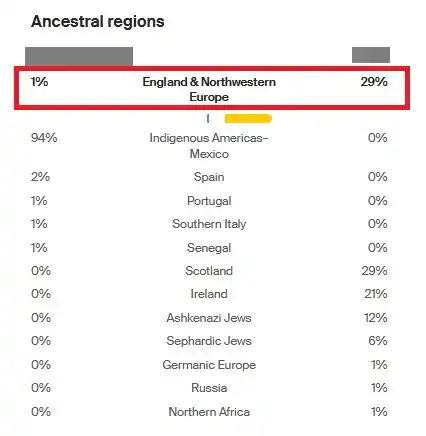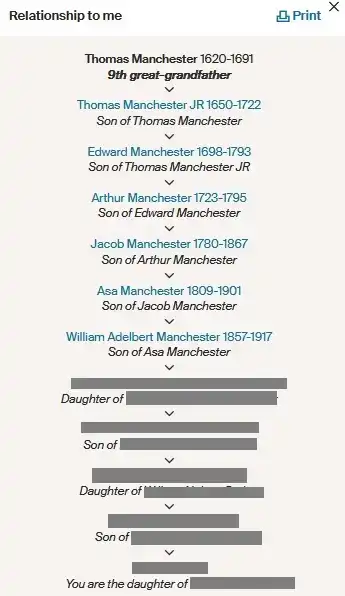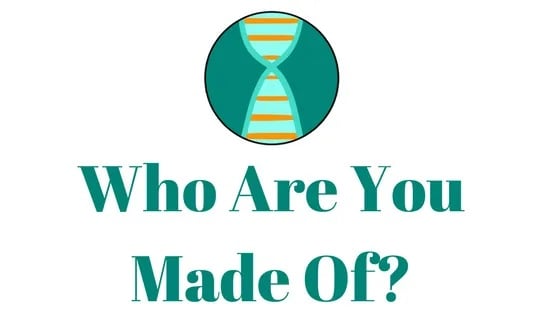Have you ever wondered how far back in your family tree DNA matches can really go? In this post, find out everything you need to know about this question.

As we all know, DNA matches share bits of DNA with us that we refer to as DNA segments. These DNA segments were passed down to us from our shared ancestor, or ancestors.
One of the best ways to figure out how you are related to your DNA matches is to compare your family tree to your DNA match's tree in order to try to find a common ancestor.
This exercise often leads to the following questions related to the topic of this article:
- Is it possible for two people to share DNA from an ancestor that lived 500 years ago?
- If you were able to identify a shared ancestor in both of your respective trees, does it mean that the DNA that you share was inherited from the ancestor that you identified?
- How can you know that a DNA segment you share with a match really came from the ancestor that you have identified as your shared ancestor?
Before we dive too deeply into answering these questions, we have to answer the question posed in the topic of this post. How far back can DNA matches really take you?
You may have DNA matches who are descended from ancestors who lived a very long time ago
Some of your DNA matches will likely be people who are descended from ancestors in your family tree who lived a very long time ago. This is especially true if you have a lot of DNA matches.
For example. I have more than 26,000 DNA matches on Ancestry. There is a good chance that the common ancestors that I share with at least a few of these DNA matches lived several hundred years ago.
If you are looking for the short answer, you should know that DNA matches likely go back at least 300-500 years. In some cases, DNA matches might go even further back.
The truth is that no one really knows exactly how far back DNA matches can go.
To learn more about this topic, keep reading.
Can DNA matches go back 500 years?
As I mentioned above, some DNA matches could be descended from an ancestor who lived as far back as 500 years ago.
To show how far back a DNA match could possibly go, I will show a DNA match from my husband's DNA match list.
My husband was born in a small, insular indigenous village in Mexico, and everyone in his family tree was born in Mexico back as far as great-great-great grandparents. Everyone in the village identifies as indigenous and almost everyone speaks Nahuatl, their ancestral language.
Several of my husband's relatives have tested their DNA, and they all have more than 90% Indigenous Americas on their results, similar to my husband's 94%. I mention this fact as evidence of what appears to be a pattern of low admixture with other groups.
Even so, my husband's results did show that 1% of his DNA matches the England and Northwestern Europe region on Ancestry.
I found a DNA match on his list that shares only a single 6 centimorgan (cM) DNA segment with him. A 6 cM DNA segment is very small, and while it could be a false segment, it may also be legitimate.

It's safe to say that at least some of my husband's 6 cM DNA matches are legitimate. If we assume that this match is a real match (more on this below), I know that their common ancestor is much further back than the early 1800s.
Based on my research of my husband's family tree, his ancestral village and people, as well as DNA testing of several of his relatives, I believe that his European ancestry is very far back in time. If this DNA match is legitimate, it could be the result of a single European ancestor from hundreds of years ago.
Remember, the Spanish arrived in Mexico more than 500 years ago.
Why it's hard to prove how far back DNA matches can go
What I've shown you here is not undeniable proof of a connection between two people. It's not even an educated guess.
In fact, it's pretty close to being pure speculation.
However, since we all have many, many DNA matches who share only tiny DNA segments with us, it's safe to assume that at least some of them are evidence of an ancestor who lived 500 or so years ago.
But, why can't we show proof of this?
You need to both have family trees going back 500 years
In order for me to get evidence that my husband and his DNA match are really related to each other, I would have to build my husband's family tree going back 500 years. I would also need a similar tree from his DNA match.
My husband's DNA match match has a family tree with thousands of people in it going back to the 1600s on many lines. However, I haven't been able to build such a complete tree for my husband.
Since my husband's tree is much smaller, I am not able to identify a common ancestor, a shared surname - or even a similar ancestral location in their trees. There is nothing to connect them.
This is one of the biggest problems in "proving" how far back we can really go with DNA matches. Almost no one has an accurate family tree built back to the 1500s on all lines of their tree.
It's just something that most of us don't have. Sure, I may have some lines of my tree that do go very far back, but I have more lines where I am stuck in the 1800s due to brick walls.
We need to know that we aren't related in more than one way
It's possible, and even likely, that we are related to many of our DNA matches in more than one way. This is because the populations of the places where our ancestors lived a long time ago was much smaller than it is today.
It's very likely that if we look carefully at our DNA match's family trees, we will spot more than one set of shared ancestors.
If we share more than one set of shared ancestors with a DNA match, we might not be able to know for sure which set of shared ancestors passed down the DNA that we share to us.
To confuse matters even more, if we don't have complete family trees and we spot more than one set of shared ancestors, we have to consider that there may be still another set of shared ancestors that we haven't yet identified.
It's hard to be sure it's not a false shared segment (IBS)
When it comes to very small DNA segments, especially those that are smaller than 12 or so centimorgans, we can expect to find a high rate of false positives. It's possible that an identical DNA segment is not due to a shared ancestor, but a result of an identical-by-state (IBS) segment.
An IBS segment is a coincidentally identical DNA segment. It just happens to be identical, but it was not inherited from a common ancestor.
I thought of this detail when I was examining one of my grandmother's DNA matches, which I share with you below. Personal information has been greyed out to protect privacy.

My grandmother shares 7 cMs with her DNA match. While Ancestry estimates them to be some variety of third cousins, I couldn't find evidence of this close relationship in their family trees.
Instead, I discovered a common ancestor that lived more than 400 years ago. Both my grandmother and her DNA match are descended from Thomas Manchester, a man who was born in 1620.

Since I found a common ancestor shared between my grandmother and her DNA match, I could immediately say "case closed". Not so fast!
It seems like my grandmother and this match are related to each other. They seem to be about eighth cousins.
However, it's still possible for the DNA segment that they share to be a false segment. The DNA segment could be an IBS segment, even though my grandmother and her match are really related to each other.
We would need to prove that the DNA segment is identical-by-descent
In order to really know that a DNA match shares DNA with you because they inherited identical DNA to yours from your shared ancestor, you would need to be able to examine your ancestor's DNA.
The goal would be to see if your parent, grandparent, great-grandparent, etc, share the same DNA segment at the same location on the same chromosome with your DNA match.
In theory, if we could actually do this, we could "prove" that the DNA segment was passed down from the shared ancestor.
When it comes to distant ancestors, such as my 9th great-grandfather, Thomas Manchester, I will not be able to test the DNA of all of my ancestors going all the way back to 1620 in order to see if they all share the same DNA segment with my grandmother's DNA match.
Recently, I stumbled across a lock of hair belonging to Thomas Ancestor's 4th great-grandson (my 3rd great-grandfather, William). The lock of hair is pinned to the Western Union telegram that his daughter received as notification of her father's death.
While I haven't decided yet, I may send some of the hair off for DNA testing. If I do, I could try to compare the results to those of my grandmother's DNA match to see if they share the same DNA segment.
If my grandmother really did inherit a DNA segment from Thomas, then William would have had to have it in order to pass it down to her.
Conclusion
I hope that this post has helped you understand how far back in your family tree you can really go with DNA matches. Only you can determine how far back your matches can take you!
The only limit is how far you are willing to go in your research.
If you have any questions about something that you read in this post, or if you would like to share a story about your connection with a DNA match (from an ancestor long ago!), I would love to hear from you in the discussion below.
Thanks for stopping by!

Jim Ward
Monday 2nd of June 2025
Ancestry DNA is a sad joke. They seem to think that any match beyond 8cM is unreliable. That's BALONEY and it's the reason why I'm a GEDmatch member and a member of dozens of Facebook ancestor/genealogy groups. One example - a new group member posted her GEDmatch kit so I ran it...15cM total on 2 chromosomes. We compared lineage and found Gardner ancestors were our link. She learned some of her history the easy way - from someone who doesn't march to antiquated DNA baloney.
Jim Ward
Monday 2nd of June 2025
@Jim Ward, Years ago, one Facebook group's admins thought they'd be elite and bar any match below 8cM, ala Ancestry. I was barred from posting images of match comp's below that number. I exited the group immediately.
Jim Ward
Monday 2nd of June 2025
Like it or not, I have made DNA connections PAST the 8th cousin by using SNPs numbers above 600 and confirming them with lineage. Otherwise, without the SNPs, we wouldn't have known and wouldn't have tried. It doesn't always work but it did enough times to know that it's not a waste of my effort.
Mercedes
Sunday 8th of June 2025
Hi Jim, I've found legit matches with very small shared segments, too! It's definitely a topic that people get pretty passionate about, and I've seen discussions get shut down on FB. The heavy-handed nature of some group admins is actually why I started my website many years ago. You might find this article interesting: https://whoareyoumadeof.com/blog/are-small-dna-segments-always-false-positives-ibs/ Thanks for your comment, Mercedes
Jim Bartlett
Sunday 1st of June 2025
I have several pieces of DNA that go back to my Neanderthal ancestors...
Jim Ward
Monday 2nd of June 2025
@Jim Bartlett, Yep, and the Denisovans too, GEDmatch Archaic DNA. Love it!